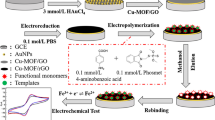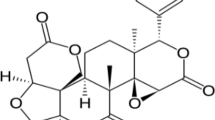Abstract
The present work is performed on Pb2+ detection via electrochemical sensor. The novel aptasensor was developed by modification of glassy carbon electrode (GCE) with reduced graphene oxide (rGO) and gold nanoparticles (AuNPs) modified with ssDNA. The synthesized nanoparticles were characterized by HRTEM (high resolution transmission electron microscopy), SAED (selected area electron diffraction), UV–Vis spectrophotometer, FTIR, and XPS. The rGO was prepared by electrochemical reduction and thickness of rGO sheet was 0.5 to 1 nm. The average AuNPs size was 20–25 nm. The Pb2+ ion binds with specific ssDNA, and it will induce conformational changes of the aptamer and corresponding modulation of electrochemical signals. The cyclic voltammetry (CV) and electrochemical impedance spectroscopy (EIS) were used for Pb2+ detection and optimization of sensor. The proposed aptasensor exhibits high sensitivity toward detection of Pb2+ ions with a detection limit of 1.52 nM and linear range of 5–50 nM at a signal-to-noise ratio of 3. Moreover, this aptasensor produces satisfactory results in environmental water samples analysis. The results of the newly developed aptasensor show better sensitivity and selectivity than the previously described electrochemical sensor.

















Similar content being viewed by others
References
Zheng J, Wai JL, Lake RJ et al (2021) DNAzyme sensor uses chemiluminescence resonance energy transfer for rapid, portable, and ratiometric detection of metal ions. Anal Chem 93:10834–10840. https://doi.org/10.1021/acs.analchem.1c01077
Cruz-Lopes LP, Macena M, Esteves B, Guiné RPF (2021) Ideal pH for the adsorption of metal ions Cr 6+, Ni 2+, Pb2+ in aqueous solution with different adsorbent materials. Open Agric 6:115–123. https://doi.org/10.1515/opag-2021-0225
Henriques B, Rocha LS, Lopes CB et al (2015) Study on bioaccumulation and biosorption of mercury by living marine macroalgae: prospecting for a new remediation biotechnology applied to saline waters. Chem Eng J 281:759–770. https://doi.org/10.1016/j.cej.2015.07.013
Rocha A, Trujillo K (2019) Neurotoxicity of low-level lead exposure: history, mechanisms of action, and behavioral effects in humans and preclinical models. Neurotoxicology 73:58–80. https://doi.org/10.1016/j.neuro.2019.02.021
Jazayeri MH, Aghaie T, Avan A et al (2018) Colorimetric detection based on gold nano particles (GNPs): An easy, fast, inexpensive, low-cost and short time method in detection of analytes (protein, DNA, and ion). Sens Bio-Sens Res 20:1–8. https://doi.org/10.1016/j.sbsr.2018.05.002
Niu X, Liu Y, Wang F, Luo D (2019) Highly sensitive and selective optical sensor for lead ion detection based on liquid crystal decorated with DNAzyme. Opt Express 27:30421. https://doi.org/10.1364/OE.27.030421
Zhang Z, Ma P, Li J et al (2019) Colorimetric and SERS dual-mode detection of lead Ions based on Au-Ag core-shell nanospheres: featuring quick screening with ultra-high sensitivity. Opt Express 27:29248. https://doi.org/10.1364/OE.27.029248
Beltrán B, Leal LO, Ferrer L, Cerdà V (2015) Determination of lead by atomic fluorescence spectrometry using an automated extraction/pre-concentration flow system. J Anal At Spectrom 30:1072–1079. https://doi.org/10.1039/C4JA00456F
Wu Y-S, Huang F-F, Lin Y-W (2013) Fluorescent detection of lead in environmental water and urine samples using enzyme mimics of catechin-synthesized Au nanoparticles. ACS Appl Mater Interfaces 5:1503–1509. https://doi.org/10.1021/am3030454
Du X, Liu Y, Wang F et al (2021) A fluorescence sensor for Pb2+ detection based on liquid crystals and aggregation-induced emission luminogens. ACS Appl Mater Interfaces 13:22361–22367. https://doi.org/10.1021/acsami.1c02585
Kushwah M, Yadav R, Gaur MS, Berlina AN (2021) Copper nanoparticles-catalysed reduction of methylene blue and high-sensitive chemiluminescence detection of mercury. Int J Environ Anal Chem 1–17. https://doi.org/10.1080/03067319.2021.1893706
Huang L, Yang L, Zhu C et al (2018) Methylene blue sensitized photoelectrochemical biosensor with 3,4,9,10-perylene tetracarboxylic film as photoelectric material for highly sensitive Pb2+ detection. Sens Actuators B Chem 274:458–463. https://doi.org/10.1016/j.snb.2018.07.135
Sandford C, Edwards MA, Klunder KJ et al (2019) A synthetic chemist’s guide to electroanalytical tools for studying reaction mechanisms. Chem Sci 10:6404–6422. https://doi.org/10.1039/C9SC01545K
Yang D, Liu X, Zhou Y et al (2017) Aptamer-based biosensors for detection of lead( ii ) ion: a review. Anal Methods 9:1976–1990. https://doi.org/10.1039/C7AY00477J
Si Y, Liu J, Chen Y et al (2018) rGO/AuNPs/tetraphenyl porphyrinnano conjugate-based electrochemical sensor for highly sensitive detection of cadmium ions. Anal Methods 10:3631–3636. https://doi.org/10.1039/C8AY01020J
Jiang P, Wang Y, Zhao L et al (2018) Applications of gold nanoparticles in non-optical biosensors. Nanomaterials 8:977. https://doi.org/10.3390/nano8120977
Kushwah M, Gaur MS, Arora K, Berlina AN (2019) Bio synthesis of colloidal AuNPs using thermally assisted pulse sonication method. Mater Res Express 6:115068. https://doi.org/10.1088/2053-1591/ab4a69
Peña-Bahamonde J, Nguyen HN, Fanourakis SK, Rodrigues DF (2018) Recent advances in graphene-based biosensor technology with applications in life sciences. J Nanobiotechnology 16:75. https://doi.org/10.1186/s12951-018-0400-z
Parnianchi F, Nazari M, Maleki J, Mohebi M (2018) Combination of graphene and graphene oxide with metal and metal oxide nanoparticles in fabrication of electrochemical enzymatic biosensors. Int Nano Lett 8:229–239. https://doi.org/10.1007/s40089-018-0253-3
Pumera M (2011) Graphene in biosensing. Mater Today 14:308–315. https://doi.org/10.1016/S1369-7021(11)70160-2
Wei Q, Zhao Y, Du B et al (2012) Ultrasensitive detection of kanamycin in animal derived foods by label-free electrochemical immunosensor. Food Chem 134:1601–1606. https://doi.org/10.1016/j.foodchem.2012.02.126
Kanchana P, Radhakrishnan S, Navaneethan M et al (2016) Electrochemical sensor based on fe doped hydroxyapatite-carbon nanotubes composite for L-dopa detection in the presence of uric acid. Nanosci Nanotechnol Lett 16:6185–6192. https://doi.org/10.1166/jnn.2016.11645
Ma Y, Yu Y, Xu M et al (2016) Facile synthesis of Ag nanoparticles functionalized carbon nanospheres and application in direct electrochemistry of hemoglobin. Nanosci Nanotechnol Lett 8:592–598. https://doi.org/10.1166/nnl.2016.2037
Kushwah M, Gaur MS, Berlina AN, Arora K (2019) Biosynthesis of novel Ag@Cu alloy NPs for enhancement of methylene blue photocatalytic activity and antibacterial activity. Mater Res Express 6:116561. https://doi.org/10.1088/2053-1591/ab485e
Wu L, Fu X, Liu H et al (2014) Comparative study of graphene nanosheet- and multiwall carbon nanotube-based electrochemical sensor for the sensitive detection of cadmium. Anal Chim Acta 851:43–48. https://doi.org/10.1016/j.aca.2014.08.021
Ruttkay-Nedecky B, Kudr J, Nejdl L et al (2013) G-quadruplexes as sensing probes. Molecules 18:14760–14779. https://doi.org/10.3390/molecules181214760
Yang D (2019) G-Quadruplex DNA and RNA. In Yang D, Lin C (eds) G-quadruplex nucleic acids: methods and protocols. Methods Mol Bio (Springer, Book Series) 2035:1–24. https://doi.org/10.1007/978-1-4939-9666-7_1
He B, Shen X, Nie J et al (2018) Electrochemical sensor using graphene/Fe3O4 nanosheets functionalized with garlic extract for the detection of lead ion. J Solid State Electrochem. https://doi.org/10.1007/s10008-018-4041-9
Liu X, Zhong J, Rao H et al (2017) Electrochemical dipyridamole sensor based on molecularly imprinted polymer on electrode modified with Fe3O4@Au/amine-multi-walled carbon nanotubes. J Solid State Electrochem 21:3071–3082. https://doi.org/10.1007/s10008-017-3650-z
Liu F, Nie J, Qin Y et al (2017) A biomimetic sensor based on specific receptor ETBD and Fe3O4@Au/MoS2/GN for signal enhancement shows highly selective electrochemical response to ultra-trace lead (II). J Solid State Electrochem 21:1–12. https://doi.org/10.1007/s10008-017-3659-3
Cheng Y, Fa H, Yin W et al (2016) A sensitive electrochemical sensor for lead based on gold nanoparticles/nitrogen-doped graphene composites functionalized with l-cysteine-modified electrode. J Solid State Electrochem 20:327–335. https://doi.org/10.1007/s10008-015-3043-0
Yadav R, Kushwah V, Gaur MS et al (2020) Electrochemical aptamer biosensor for As3+ based on apta deep trapped Ag-Au alloy nanoparticles-impregnated glassy carbon electrode. Int J Environ Anal Chem 100:623–634. https://doi.org/10.1080/03067319.2019.1638371
Marinoiu A, Raceanu M, Andrulevicius M et al (2020) Low-cost preparation method of well dispersed gold nanoparticles on reduced graphene oxide and electrocatalytic stability in PEM fuel cell. Arab J Chem 13:3585–3600. https://doi.org/10.1016/j.arabjc.2018.12.009
Wang Y, Hu S (2016) Applications of carbon nanotubes and graphene for electrochemical sensing of environmental pollutants. J Nanosci Nanotechnol 16:7852–7872. https://doi.org/10.1166/jnn.2016.12762
Singh S, Tuteja SK, Sillu D et al (2016) Gold nanoparticles-reduced graphene oxide based electrochemical immunosensor for the cardiac biomarker myoglobin. Microchim Acta 183:1729–1738. https://doi.org/10.1007/s00604-016-1803-x
Xu F, Pellino A, Knoll W (2008) Electrostatic repulsion and steric hindrance effects of surface probe density on deoxyribonucleic acid (DNA)/peptide nucleic acid (PNA) hybridization. Thin Solid Films 516:8634–8639. https://doi.org/10.1016/j.tsf.2008.06.067
Li MJ, Liu CM, Cao HB, Zhang Y (2013) Surface charge research of graphene oxide, chemically reduced graphene oxide and thermally exfoliated graphene oxide. Adv Mat Res 716:127–131. https://doi.org/10.4028/www.scientific.net/AMR.716.127
Aswathy B, Avadhani GS, Suji S, Sony G (2012) Synthesis of β-cyclodextrin functionalized gold nanoparticles for the selective detection of Pb2+ ions from aqueous solution. Front Mater Sci 6:168–175. https://doi.org/10.1007/s11706-012-0165-5
Watson SMD, Mohamed HDA, Horrocks BR, Houlton A (2013) Electrically conductive magnetic nanowires using an electrochemical DNA-templating route. Nanoscale 5:5349–5359. https://doi.org/10.1039/C3NR00716B
Rolim T, Cancino J, Zucolotto V (2015) A nanostructured genosensor for the early diagnosis of systemic arterial hypertension. Biomed Microdevices 17:3. https://doi.org/10.1007/s10544-014-9911-z
Chand P, Pakade YB (2013) Removal of Pb from water by adsorption on apple pomace: equilibrium, kinetics, and thermodynamics studies. J Chem 2013:e164575. https://doi.org/10.1155/2013/164575
Murgunde BK, Rabinal MK, Kalasad MN (2018) Biologically active nanocomposite of DNA-PbS nanoparticles: a new material for non-volatile memory devices. Appl Surf Sci 427:344–353. https://doi.org/10.1016/j.apsusc.2017.08.001
Li Y-K, Li W, Liu X et al (2019) Functionalized magnetic composites based on the aptamer serve as novel bio-adsorbent for the separation and preconcentration of trace lead. Talanta 203:210–219. https://doi.org/10.1016/j.talanta.2019.05.075
Song S, Wang L, Li J et al (2008) Aptamer-based biosensors. TrAC Trends Anal Chem 27:108–117. https://doi.org/10.1016/j.trac.2007.12.004
Bertana V, Scordo G, Parmeggiani M et al (2020) Rapid prototyping of 3D organic electrochemical transistors by composite photocurable resin. Sci Rep 10:13335. https://doi.org/10.1038/s41598-020-70365-8
Pu Y, Wu Y, Yu Z et al (2021) Simultaneous determination of Cd2+ and Pb2+ by an electrochemical sensor based on Fe3O4/Bi2O3/C3N4 nanocomposites. Talanta Open 3:100024. https://doi.org/10.1016/j.talo.2020.100024
Fonseca Guerra C, Bickelhaupt FM, Snijders JG, Baerends EJ (2000) Hydrogen bonding in DNA base pairs: reconciliation of theory and experiment. J Am Chem Soc 122:4117–4128. https://doi.org/10.1021/ja993262d
Schweitzer BA, Kool ET (1995) Hydrophobic, non-hydrogen-bonding bases and base pairs in DNA. J Am Chem Soc 117:1863–1872. https://doi.org/10.1021/ja00112a001
Bhattacharyya D, Mirihana Arachchilage G, Basu S (2016) Metal cations in G-quadruplex folding and stability. Front Chem 4:38. https://doi.org/10.3389/fchem.2016.00038
Li X, Zheng K, Zhang J et al (2015) Guanine-vacancy–bearing G-quadruplexes responsive to guanine derivatives. Proc Natl Acad Sci USA 112:14581–14586. https://doi.org/10.1073/pnas.1516925112
Adam W, Grimison A, Hoffmann R, Zuazaga de Ortiz C (1968) Hydrogen bonding in pyridine. J Am Chem Soc 90:1509–1516. https://doi.org/10.1021/ja01008a019
Zhou W, Saran R, Liu J (2017) Metal sensing by DNA. Chem Rev 117:8272–8325. https://doi.org/10.1021/acs.chemrev.7b00063
Yantasee W, Lin Y, Hongsirikarn K et al (2007) Electrochemical sensors for the detection of lead and other toxic heavy metals: the next generation of personal exposure biomonitors. Environ Health Perspect 115:1683–1690. https://doi.org/10.1289/ehp.10190
Yadav R, Berlina A, Zherdev A et al (2020) Rapid and selective electrochemical detection of Pb ions using aptamer-conjugated alloy nanoparticles. SN Appl Sci. https://doi.org/10.1007/s42452-020-03840-6
Riyanto R (2014) Determination of lead in waste water using cyclic voltammetry by platinum wire electrode. Eksakta: JurnalIlmu-Ilmu MIPA 14(2):22–23. https://doi.org/10.20885/eksakta.vol14.iss2.art3
Hudah N, Rahman B, Tee T, Sirat K (2011) Adsorption enhancement of Pb(II) ion in the presence of nicotinic acid during cyclic voltammetry. Int J Electrochem Sci 6:3118–3128
Magerusan L, Socaci C, Coros M et al (2017) Electrochemical platform based on nitrogen-doped graphene/chitosan nanocomposite for selective Pb2+ detection. Nanotechnology 28:114001. https://doi.org/10.1088/1361-6528/aa56cb
Xiao Y, Rowe AA, Plaxco KW (2007) Electrochemical detection of parts-per-billion lead via an electrode-bound DNAzyme assembly. J Am ChemSoc 129:262–263. https://doi.org/10.1021/ja067278x
Sajjan VA, Aralekallu S, Nemakal M et al (2020) Nanomolar detection of lead using electrochemical methods based on a novel phthalocyanine. Inorganica Chim Acta 506:119564. https://doi.org/10.1016/j.ica.2020.119564
Sarmiento V, Lockett M, Sumbarda-Ramos EG, Vázquez-Mena O (2021) High performance Pb+2 detection using CVD-produced high quality multilayer reduced graphene oxide. NanoEx 2:010023. https://doi.org/10.1088/2632-959X/abe057
Acknowledgements
We are thankful to the Indo-Russia Joint Research Programme. The comparative assessment of different analytical formats was implemented under the support of the Ministry of Science and Higher Education of the Russian Federation.
Funding
This study is financially supported by the Department of Science and Technology, New Delhi, India (Letter no. #DST/INT/RUS/RSF/P-28/G).
Author information
Authors and Affiliations
Corresponding author
Ethics declarations
Conflict of interest
The authors declare no competing interests.
Additional information
Publisher's Note
Springer Nature remains neutral with regard to jurisdictional claims in published maps and institutional affiliations.
Rights and permissions
Springer Nature or its licensor (e.g. a society or other partner) holds exclusive rights to this article under a publishing agreement with the author(s) or other rightsholder(s); author self-archiving of the accepted manuscript version of this article is solely governed by the terms of such publishing agreement and applicable law.
About this article
Cite this article
Kushwah, M., Yadav, R., Berlina, A.N. et al. Development of an ultrasensitive rGO/AuNPs/ssDNA-based electrochemical aptasensor for detection of Pb2+. J Solid State Electrochem 27, 559–574 (2023). https://doi.org/10.1007/s10008-022-05344-2
Received:
Revised:
Accepted:
Published:
Issue Date:
DOI: https://doi.org/10.1007/s10008-022-05344-2




